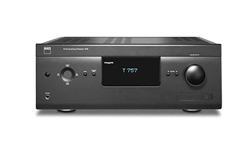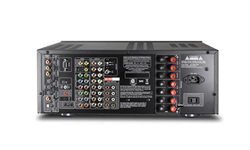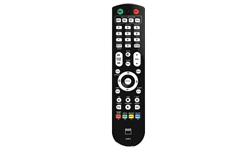Introduction to the NAD T757 Receiver
Like most people I have some pet peeves. When I shop for televisions, I am always hoping to find one without speakers. I have a dedicated theater with speakers and electronics that are leaps and bounds ahead of what I could possibly get in a TV. I don’t need speakers; I’ll never turn them on. I don’t want them! Simply having them adds cost, complexity, and size to my TV. I don’t want to pay for what I won’t use! Give me the best picture for the buck possible so I can a get real monster of a TV so I really feel like I am in a theater. OK, deep breath – rant over. But the reason I bring this up is that I think the folks over at NAD would have been nodding as they read my rant.
NAD T757 RECEIVER SPECIFICATIONS
- Design: 7.1 A/V Receiver
- Power: 7 Channels x 60 Watts Full Disclosure Power (FDP)
- Codecs: All Dolby and DTS, including Dolby TrueHD and DTS-HD Master Audio
- HDMI v1.4
- Audyssey
- Dimensions: 6.8″ H x 17.1″ W x 15.7″ D
- Weight: 33.9 Pounds
- MSRP $1,600 USD
- NAD
- SECRETS Tags: Receivers, NAD
NAD, started as New Acoustic Dimension back in 1972, has a reputation for offering premium performance in their gear at attractive prices. They do this by focusing on getting the core features on each of their products absolutely correct. They do not throw in doodads that do not contribute to the performance of the product. This review will look at how this philosophy was applied to one of their latest receivers, the NAD T 757.
Design of the NAD T757 Receiver
Out of the box, NAD’s T 757 has the core features required to make a modern centerpiece to your home theater. The NAD offers 60 watts of power for each of its 7 channels. This is rated with all 7 channels simultaneously driven from 20Hz-20kHz at rated distortion. This is an honest power rating versus claimed 100 watt per channel receivers selling for a few hundred bucks. Even better, if you use 5 channels for your surround system you can repurpose two of those amplifier channels to bi-amp your main left and right speakers (perfect of my Infinity Betas Towers).
These channels of amplification can be fed by a traditional AM/FM radio from the built in tuner. Or as many of you will, the T 757 offers an array of analog (3) and digital (6) audio inputs that can decode the various surround formats available from traditional Dolby Surround to the latest Dolby True HD and DTS Master Audio (and everything in between).
For video (Audio and Video for HDMI), NAD’s T 757 has composite (2), s- video (1), component (3), and HDMI (4) inputs. The HDMI inputs are version 1.4 which includes 3D support. The T 757 will cross-convert the legacy video connections to HDMI to allow you to run a single HDMI cable versus a bundle of video options making your hook up life easier. However, the receiver does not process or up convert the video to a single output resolution for these legacy analog or digital signals.
One of the things NAD is very proud of is the upgrade path provided on this receiver. It seems like they have taken a page from the higher end of the world of personal computers and have moved components likely to be upgraded to a sub chassis / daughter card. For the PC, this would typically be a high end graphics card. For the NAD, it is the digital audio video section including the ever evolving HDMI connections. NAD calls their technology, Modular Design Construction (MDC). Unlike PCs, to upgrade a NAD receiver you’ll be locked into NADs proprietary solution. A visit to a NAD dealer and an NAD estimated $200-$600 will upgrade your receiver to the latest digital standards (Mega Master Pro Super Surround?). This upgrade would include the hardware and any associated firmware required. I’ve discovered NAD also has the ability to upgrade the firmware separately as my unit was upgraded during my review cycle. Contact your NAD dealer for more information.
How valuable this MDC will be to you is debatable. At $1600, the T 757 is currently the least costly receiver offered by NAD to offer MDC. If the cost of the upgrade creeps closer to $600 I personally would hesitate upgrading the T 757 as the cost of the upgrade approaches half the cost of replacement. At $200 on the other hand an upgrade may make more sense. The higher the price of the piece of gear, the more appealing this feature gets. So as you move to NADs higher priced receivers, MDC becomes even more appealing.
Setup of the NAD T757 Receiver
Setup of NAD’s T 757 was mostly quick and painless. I swapped out my Marantz SR7002 for the T 757 and simply swapped out my bundle of Monster cables from one to the other. I used the following gear along with the NAD during my evaluation:
- Main Speakers: Infinity Beta 50 Towers (https://hometheaterhifi.com/volume_12_1/infinity-beta-speakers-2-2005-part-1.html)
- Center Speaker: Infinity Beta C360
- Surround Speaker: Infinity Beta ES250 (Bi-pole mode)
- Subwoofer: Custom Build Isobaric Pyramid (https://hometheaterhifi.com/volume_13_2/diy-pyramid-subwoofer-4-2006-part-1.html)
- Subwoofer Amplifier: Sonance Sonamp Cinema 2120 – THX Ultra rated
- Display: Samsung LN55A950 (my “tiny” TV – with my aging eyes I need something larger … right dear?)
- Supplemental Amplifier: Bryston 4bSSt2 https://hometheaterhifi.com/power-amplifiers/673-bryston-4b-sst2-c-series.html
- Blu-ray Player: Panasonic DMP-BD35
- Blu-ray Player: Sony BDP-S5000ES “https://hometheaterhifi.com/blu-ray-players/blu-ray-players-reviews/sony-bdp-s5000es-blu-ray-player.html
- DVR: TiVo HD
- Sony PlayStation 3 60GB
With the connection in place it was time to configure my system for optimum performance with the NAD. The T 757 offers an Audyssey system to perform a basic surround sound system setup. This means the T 757 will automatically detect the speakers connected, determine their size, set speaker levels, and set distance of each speaker to the main listening position. Unlike many receivers in this price class, the T 757’s Audyssey implementation does not correct for your room’s sonic imperfections using Audyssey MultEQ technology (or any of their other advanced processing options).
Note that if you check the Audyssey web site you will not notice this ‘configuration only’ product listed. NAD’s implementation isn’t typical of what is offered by Audyssey today and was grandfathered in for NAD’s use. Instead, the T 757 focuses on the basic setup. According to Greg Stidsen, Technology and Product Planning Director at NAD, this was a conscious decision on the T 757 to reach the target price and reflect the design philosophy of the T 757 – simple but high performing.
In practice, I ran into an issue running the Audyssey speaker setup. It reported a number of times that the polarity of my main speakers were out of phase (positive and negative wires swapped). I verified that this was not true. Again I spoke to Greg at NAD for an explanation. It turns out that Audyssey phase test used relies on detecting the time from the test tone on the speaker to the time the microphone detects the echo or reflection of the tone. In my room, the time between the tone and the echo was too close for the T 757 to accurately determine phase. I did not notice that the wording used at the end of the test indicated that there was a potential issue and not a problem. The T 757 was just providing me a heads up to a potential issue. Be warned, read carefully when running the Audyssey setup in your system.
The NAD T757 Receiver In Use
Video Performance
Once I successfully integrated the NAD T 757 in my own system it was time to play. First I focused on the T 757’s video performance. As I noted earlier, the T 757 simply passes through digital video in their original format so you may wonder why I bothered at all. Well this very lack of video processing uncovered an issue in my system.
As you can see from the photo above, I was getting a number of video artifacts. These were something I hadn’t seen previously. I debugged a bit and originally suspected a firmware bug in the NAD’s video processing. I was seeing the issue when I changed video resolution. With my TiVo setup to pass through native resolution (480i, 720p, 1080i etc.) this was a regular and frustrating occurrence. I contacted NAD for their help. Greg again came through with an explanation. While I could paraphrase I think it is best simply to relay exactly what I was told in a number of correspondences.
(From Greg) “The HDMI issue is most likely the Display device reacting to the HDCP re-authentication that is required when there is a change in resolution. Basically there is a momentary loss of video sync. Because we support native resolution of the source, the output of the T 757 will change when the source changes. Some Displays handle the re-authentication more elegantly than others.”
So the issue was not with the NAD, but rather with my Samsung LN55A950. As a workaround I simply setup my TiVo to output all video at a fixed 1080i. The TiVo more elegantly unconverted all video masking the issue in the Samsung.
I asked Greg for an explanation on NADs design decision. While it is rather lengthy, I think this is worth sharing with you.
“There was a time when including a video processor in the AVR made sense. Although most digital source components (disc players and set-top boxes) already included video processing, and all digital TVs include video processing, many analog sources were still in use. Even though the TV could perform this function, it was often accomplished with low cost devices giving rather poor results. It also required switching sources on both the AVR and the TV to accommodate the various signal formats which was not very convenient. For this reason NAD has offered high quality processing using Faroudja DCDi and Gennum (now Sigma) VXP video processors in many of our AVR’s.
Accurately converting from lo-res interlaced analog video (480i) to hi-res progressive scan video (720p/1080p) required a very high performance video processor, one that could perform line doubling while preventing side effects like motion artifacts. Additional processing was often included to adjust for different screen proportions (aspect ratios) and video noise reduction, just to name a couple of common features. Even with digital video sources like DVD players, video processors upscale video resolution from 480p to 720p or 1080p and adjust frame cadence between film (24fps) and video (60fps) – commonly known as 3:2 Pulldown – to give smooth motion.
Today, most sources are natively digital (including all broadcast) and often natively HD and do not benefit from additional video processing. In fact, multiple processing can result in a significant reduction in picture quality. This is why we now advocate the elimination of video processing in AVR’s.
A prime example of this degradation occurs when the frame rate is altered multiple times between 24fps and 60fps. Sometimes the resolution is automatically changed by the EDID channel of HDMI and it is not immediately obvious to the viewer. Usually it is not that easy to know how each device is set without checking it every time a new source or program is selected. This is laborious for the video expert and beyond comprehension for the average TV viewer. The option in most Blu-ray players to fix the output to 24fps (avoiding 3:2 pulldown for better results with film based sources) only made this problem more common and confusing.
The chart below shows how frames are dropped when there are multiple frame rate conversions. Once frames are dropped they cannot be recovered by subsequent processing.
Audio Performance
As a parent of 3 myself, my parents gave my wife and me the best possible present possible for our recent wedding anniversary – they took all three kids for the weekend. Even the two year old! Given this opportunity we were able to enjoy some late night movie action and were really able to wring out the T 757’s audio performance.
Since it was our anniversary, we went with something romantic, Thor. Our first attempts to watch the Thor Blu-Ray did not go smoothly. The DTS-Master audio used was not decoded correctly by the NAD. It seems the NAD was not able to decode the signal, no sound was present. I was able to correct this by cycling power on both the NAD and my Panasonic Blu-ray. I retried the movie on the Panasonic and my Sony Blu-ray and was not able to reproduce the problem reliably. I spoke to Greg (again) and the best we could figure is a temporary glitch. Greg was suspicious of the Panasonic. But without a reproducible bug we never did root cause the issue.
Back to Thor, once it did start playing was the NAD’s 60 watts sufficient to handle this action packed movie? I’d say yes – and so would my neighbor Jim whom I kept up that night. Thor was playing loud enough to bleed the soundtrack into his house and shake his walls through 2 2×6 walls, 50 feet and 2 sets of closed triple paned windows. Now did the NAD sound as effortless alone playing the movie as when I added my Bryston amp in for my main Infinity Beta towers? No. At these Jim rousing levels I could detect the NAD straining especially with the center channel compared to when the Bryston was added via the T 757 pre-amp outputs. I love to see that feature in a receiver since it makes the power upgradeable. Powering my towers with my Bryston freed up a lot of power from the NADs supply – power that could be dedicated to the center channel. I’d say that unless you’d like to wake your neighbor, the NAD is plenty powerful. Note that my Infinity speakers are relatively easy to drive with a sensitivity of 91db, if you have less efficient speakers an amplifier upgrade or move up to a more powerful NAD receiver may be warranted.
While I am sure many reviewers would pull out a audiophile quality recording of the London Philharmonic or something to check the stereo performance of the T 757, I decided instead to follow my heart. My heart likes all kinds of cra… umm music it turns out. This week it meant I was listening to an eclectic 70’s mix. I pulled out my copy of Rhino’s “Have a Nice Decade”. This is a 7 seven disk, 9 hour collection from Rhino of some of your 70’s favorites or songs you may have missed (or avoided). Everything from the Five Man Electrical Bands “Signs” on disk 1 to the Commodores “Brick House” on disk 7 sounded great on the NAD. The songs themselves sounded great and I enjoyed hearing them played with the NAD. I can’t think of a better recommendation.
Performance
NAD’s T 757 was one of the easiest receivers to operate that ever entered my home (once I provided a work around for the aforementioned video issues which confused them). My young children as well as my wife had no issues operating the T 757 (this is not always the case). During my setup, I was able to label each of the inputs to match the source, Sony Blu-ray, TiVo, PlayStation, and so on. They were each able to select source they desired by matching the displayed source to what they wanted. They all found it easiest to press the front panels “Source” to access what they wanted (probably since my 2 year old hid the remote again). I liked to see that the NAD was able to display volume level on the display over HDMI – a feature missing on my previous generation Marantz receiver (ahh progress).
The T 757 remote is well designed. The layout is simple and intuitive. I found it much preferable to the other receiver remotes I have used. I do wish for a full backlight. Other than that I have no complaints.
Conclusions about the NAD T757 Receiver
Now while the NAD T 757 did not fly through my theater without issue, every issue I discovered was explainable and had a work around. I do not fault NAD for the design decision they made. I think that if you are looking for an exceptionally simple to operate yet high performance home theater receiver you can’t go wrong with the NAD T 757.
I’d also like to thank the folks over at NAD, especially Greg, for their high level of support.






